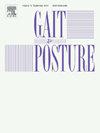帕金森病患者地面运动训练后的步行步态推进力:一项初步研究
IF 2.2
3区 医学
Q3 NEUROSCIENCES
引用次数: 0
摘要
帕金森氏症(PD)患者的行走能力经常受损。地上运动训练(OLT)促进了这一人群行走能力的改善,但其对行走推进力的影响尚不清楚。研究问题:OLT对PD患者行走推进力的影响是什么?方法一项预实验、先导研究,11名轻中度PD患者(年龄69.7 ± 4.9岁)(Hoehn &;Yahr期1-3),完成12周OLT。结果包括前地反力峰值(AGRF)、AGRF上升时间(RT)、推离冲量和推离持续时间;峰值后地反力;单站持续时间,推离时质心到压力中心的距离;还有步行速度。测试了干预前后的结果差异,并计算了效应量。结果OLT后,AGRF的RT有显著性差异(p = )。015, Cohen’s d=.879),推离冲量(p = )。026, Cohen’s d=.789),推离持续时间(p = 。021, r = .697),单站持续时间(p = 。004, r = .857),步行速度(p = 。012, Cohen’s d=1.18)。AGRF峰、PGRF峰或como - cop距离无显著差异。结果表明,OLT改善了PD患者某些方面的行走能力。参与者加快了步行速度,减少了站立阶段的时间和蹬蹬时间,减少了AGRF的RT。参与者表现出更快,更强大的AGRF,峰值AGRF或推离姿势没有变化。AGRF的RT可能是该人群中推进力产生的一个重要但尚未得到充分研究的决定因素。本文章由计算机程序翻译,如有差异,请以英文原文为准。
Walking gait propulsive force in individuals with Parkinson’s disease following overground locomotor training: A pilot study
Background
Walking is often impaired in individuals with Parkinson’s disease (PD). Overground locomotor training (OLT) promotes improved ambulation in this population, but its effects on walking propulsive force remain unknown.
Research question
What are the effects of OLT on walking propulsive force in individuals with PD?
Methods
A pre-experimental, pilot study, eleven participants (age 69.7 ± 4.9 years) with mild to moderate PD (Hoehn & Yahr stage 1–3), completed 12 weeks of OLT. Outcomes included peak anterior ground reaction force (AGRF), AGRF rise time (RT), push-off impulse, and push-off duration; peak posterior ground reaction force (PGRF); single stance duration, center of mass (COM) to center of pressure (COP) distance at push-off; and walking speed. Pre- and post-intervention outcome differences were tested, and effect sizes were calculated.
Results
Following OLT, significant differences were found for RT of the AGRF (p = .015, Cohen’s d=.879), push-off impulse (p = .026, Cohen’s d=.789), push-off duration (p = .021, r = .697), single stance duration (p = .004, r = .857), and walking speed (p = .012, Cohen’s d=1.18). No significant differences were found for peak AGRF, peak PGRF, or COM-COP distance.
Significance
Results suggest OLT improved some aspects of walking ability in individuals with PD. Participants increased walking speed, spent less time in stance phase and push-off duration and decreased the RT of the AGRF. Participants exhibited a quicker, more powerful AGRF with no change in peak AGRF or push-off posture. The RT of the AGRF may be an important yet understudied determinant of propulsive force generation in this population.
求助全文
通过发布文献求助,成功后即可免费获取论文全文。
去求助
来源期刊

Gait & posture
医学-神经科学
CiteScore
4.70
自引率
12.50%
发文量
616
审稿时长
6 months
期刊介绍:
Gait & Posture is a vehicle for the publication of up-to-date basic and clinical research on all aspects of locomotion and balance.
The topics covered include: Techniques for the measurement of gait and posture, and the standardization of results presentation; Studies of normal and pathological gait; Treatment of gait and postural abnormalities; Biomechanical and theoretical approaches to gait and posture; Mathematical models of joint and muscle mechanics; Neurological and musculoskeletal function in gait and posture; The evolution of upright posture and bipedal locomotion; Adaptations of carrying loads, walking on uneven surfaces, climbing stairs etc; spinal biomechanics only if they are directly related to gait and/or posture and are of general interest to our readers; The effect of aging and development on gait and posture; Psychological and cultural aspects of gait; Patient education.
 求助内容:
求助内容: 应助结果提醒方式:
应助结果提醒方式:


